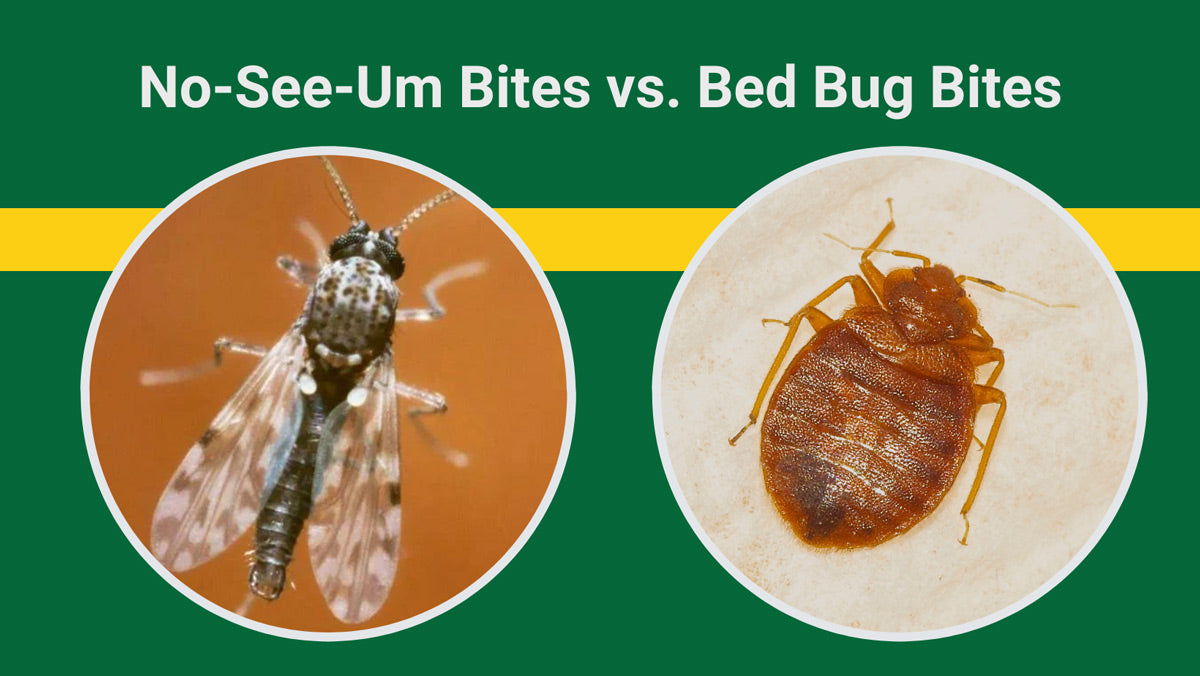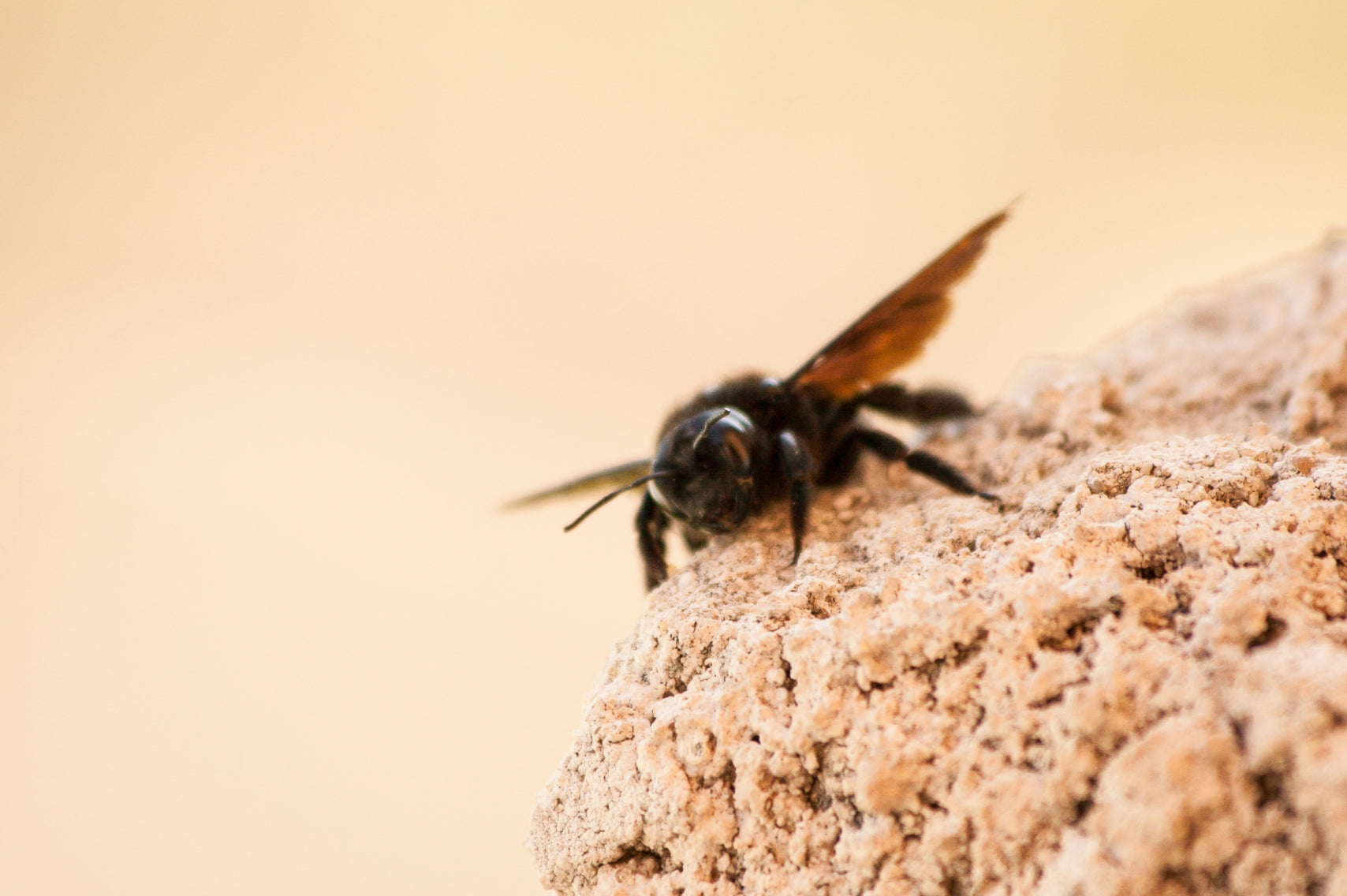Two creatures that leave irritating bites in their wake often have their victims confused and wondering, “Do I have bed bugs?” But no-see-ums, another tiny pest, also plague humans. Read on to learn more about which mystery bites are caused by these bugs and what you can do to stop them.

What Are Bedbugs?
Bed bugs are very small, flat-bodied parasitic insects that feed exclusively on human and animal blood. While they are unable to fly, bed bugs are remarkably fast on their feet as they crawl over floors, up walls and onto ceilings. The relatively flat surface area of their bodies aids bedbugs in remaining undetected as they tend to quietly escape notice, nuzzling themselves into very small spaces, hitching rides on bags and clothing or else hiding in bedsheets, in mattress seams and on other household furniture.
Generally speaking, bed bugs tend to hide during the day and leave the protection of their dwellings only at night, in order to find their next blood meal. Female bed bugs also have the capacity to lay hundreds of eggs, and young adolescent bed bugs will shed their exoskeletons several times before reaching full maturation. There are two species of bed bugs that are usually responsible for human infestations: Cimex lectularius and C. hemipterus. 1

In terms of environmental preferences, bed bugs can be somewhat temperamental in their tastes. They prefer an environment that is not too hot, not too cold, not too wet and not too dry. Unfortunately for us, so do most humans. This explains why the inside of an insulated home provides the ideal environment for a bedbug to hunker down in. In fact, a bedbug can survive for 3 to 5 months at room temperature without a blood meal, and can live up to 15 months at lower temperatures (bed bugs dry out at higher temps and don’t survive as long)2. This can make extermination that much more complicated, as the insects are notorious for lulling homeowners into a false sense of security as they secretly bide their time.
Although they are a nuisance, the good news is that there is no current body of evidence to show that bed bugs transmit diseases. Moreover, if you’re faced with a bedbug infestation, know that having bed bugs in your home is not indicative of a lack of proper hygiene, as they can be hard to rid through regular laundering and cleaning – but more on that later.
What Are No-See-Ums?
No-see-ums, tiny flies colloquially known as biting midges, biting gnats, or sand flies, can be difficult to spot due to their small size, especially when they haven’t fed. Unlike bed bugs, no-see-ums do not exclusively feed on the blood of other animals, and therefore cannot be considered parasitic (at least not entirely so).

Like female mosquitoes, female no-see-ums will bite only when they require a protein-rich meal, for example, when they are producing eggs. When they are not actively reproducing, both males and females prefer to feed on plant nectar. No-see-ums are attracted to moist, damp places, and the female no-see-um will actively look for just such a suitable location to deposit her eggs.
As for development, the young no-see-um has a four-stage life cycle consisting of an egg, larva, pupa and adult. After mating, female no-see-ums can lay hundreds of eggs and may breed several times during their life (much like bedbugs). The preferred habitat of the typical no-see-um is usually near gardens, ponds, forests, and other outdoor areas, especially when there is water nearby. These pesky little insects prefer to have their breeding grounds located in wet sand and other humid environments. However, they have been known to play “house” inside residential homes as well.
Commonly and mistakenly referred to as “sand flies,” no-see-ums in the United States are a species of biting midge called Culicoides furens. This species, while related, is a distinct insect, different from disease-vector sand flies in other parts of the world. Those disease-carrying sand flies, or Lutzomyia verrucarum, are found in parts of South America (particularly in the tropical regions of Colombia, Ecuador and Peru) and are capable of transmitting a variant of Bartonella bacilliformis that can manifest itself as Carrion’s disease in humans. Left untreated, this infectious disease can cause hemolytic fever – a condition that interferes with the body’s blood-clotting abilities – with fatality rates over 90 percent.3
While some species of Culicoides in the US do carry parasites and are known vectors of diseases in ruminant livestock, the threat to humans is low. In general, no-see-ums are primarily a nuisance, and at worst tend to cause mild allergic reactions and irritation. To reiterate, the species of no-see-ums located in the continental US are not known to carry blood-borne pathogens that affect humans.
Bite Pattern: Bed Bugs vs. No-See-Ums
Despite their small size, female no-see-ums have mandibles that are designed to effortlessly penetrate skin. Translation: big chompers mean big hurt! Though it’s probably not a fair comparison to a wasp or bee sting, a bite from a no-see-um is certainly not pleasant.
The bite pattern for no-see-ums is in some ways comparable to that of the bedbug. Both species of insects bite in clusters that produce irritated, itchy, red welts. The primary difference between a no-see-um bite and that of a bedbug, however, is that bed bugs tend to leave a trail of evidence in a straight or zigzagging line down the body. This will appear almost like a set of red tracks moving vertically or horizontally across the body of the affected individual.
In contrast, the no-see-um bite will often be clustered in a less uniform pattern. Moreover, while the biting of humans is confined only to female no-see-ums, both sexes of bed bugs bite humans. Thus, you can expect more bites over a shorter period of time from a bedbug infestation (since both the males and the females are, literally, out for blood).
How Long Do the Bites Last?
Whether you’re contending with a no-see-um swarm or an interruption of crawly critters in your sheets, the bites between no-see-ums and bed bugs typically heal within a period of one to two weeks. On average, a no-see-um bite lasts a bit longer than other blood-feeding insects due to the nature of how they bite. Unlike bedbugs, or mosquitoes for that matter, no-see-ums don’t use a proboscis (a pointy tube-like structure) to puncture their victim’s skin. Instead, their sharp jaws slice open the skin, which in turn creates a larger surface area that your body has to heal.
Conclusion: bedbug bites may be more numerous, itchy, and clustered in a line or zigzag pattern, but typically heal faster.
Bugs in Your Home
In the event that either of these insects have set up shop in your home, it’s imperative that you take action right away to prevent further infestation from occurring.
When it comes to no-see-ums, the approach is fairly simple. Because of their preference for moist, warm areas, simply having your AC running at a cool temperature (along with a dehumidifier to dry out the air inside your home) can prevent no-see-ums from getting inside your property or staying for too long if they are already there. Additionally, no-see-ums are naturally weak fliers and can be deterred by a simple overhead fan. Bedbugs, on the other hand, are not as easy to get rid of.
While extreme heat, and extreme cold can in fact kill bed bugs, this is generally not the best course of action for DIYers. The emphasis here is on the word extreme. To kill a bed bug with cold, you would need to set the temperature of your home to frigid levels, hovering around 0 degrees Fahrenheit. Conversely, a balmy 113 degrees Fahrenheit 4 would also be sufficient to eliminate bed bugs in your home. Yet setting your thermostat to that level is just not a realistic option for most people.
Instead, the best method is simply to call a professional exterminator, who may heat treat your home with special equipment. Bed bugs can multiply at an astonishing rate, and attempting to rid them yourself may actually exacerbate the problem. That being said, if DIY is in your blood (no pun intended), then we recommend the use of a steam cleaner over all infested areas. The high heat is extremely effective in killing bed bugs – just make sure it doesn’t have too forceful an airflow, or else you risk spreading the bugs further around your home.
For Your Protection: Best Bee Brothers Products
To prevent no-see-um bites from happening in the first place, we recommend our No-See-Um Repellent, which includes a powerful insect-repelling combination of natural lemongrass, geranium and peppermint essential oils. No-see-ums may not like the scent one bit, but we’re sure you will!
If it’s too late and the damage has already been done (ouch!), then the next best option is to pick up the Best Bee Brothers Bug Bite Extractor, which uses gentle suction to remove the venom or saliva from below the surface of your skin, extracting the irritant of any biting insect (including bed bugs!). Simply place the Bug Bite Extractor over the bite, use two fingers to lift the plunger and suck out the venom, and feel instant relief! This will help in the recovery process and make that pesky little bite less irksome to deal with!
Resources:
- “Bed Bugs,” Centers for Disease Control and Prevention, December 4, 2017, https://www.cdc.gov/dpdx/bedbugs/index.html#:~:text=The%20two%20species%20of%20bed,hemipterus.
- Barb Ogg, “Bed Bug Myths—Rely on Research for Facts,” March 2012, University of Nebraska Lincoln Extension, https://lancaster.unl.edu/pest/resources/347BBMyths.pdf.
- Meritxell Garcia-Quintanilla, Alexander A. Dichter, Humberto Guerra, and Volkhard A. J. Kempf, “Carrion’s Disease: More Than a Neglected Disease,” Parasites & Vectors 12, no. 141 (March 2019): https://doi.org/10.1186/s13071-019-3390-2.
- “Bed Bugs,” EPA, June 1, 2022, https://www.epa.gov/bedbugs/do-it-yourself-bed-bug-control.









Leave a comment
All comments are moderated before being published.
This site is protected by hCaptcha and the hCaptcha Privacy Policy and Terms of Service apply.